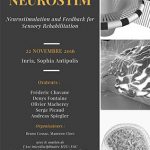This workshop proposes to share different standpoints (physical, mathematical, biological, clinical) and to study the current state of the art in the domain of neurostimulation and feedback for sensory rehabilitation. It also aims at pointing out some current limitations with the hope of coming up with possible fundamental principles with which these limitations could be addressed. It is positioned at the interface between modelling, experiments and clinical applications, in the fields of retinal, cochlear, and cortical stimulation with the following point of view:
Models can be used to represent parts of the simulated system, consisting of the stimulating device and the targeted parts of the nervous system as well as its response and the resulting perceived effect on the implanted human. Standard modelling approaches based on reverse engineering are relatively efficient in some cases but are de facto limited by the angle under which they tackle the problems. Indeed, they consider the simulated system as an input-output black box with a “mechanistic” and functional point of view neglecting specificities of the nervous system and hindering access to possible fundamental principles. The goal of this workshop will therefore be to identify possible ways to go beyond this reverse engineering approach.






Pingback: pharmacies